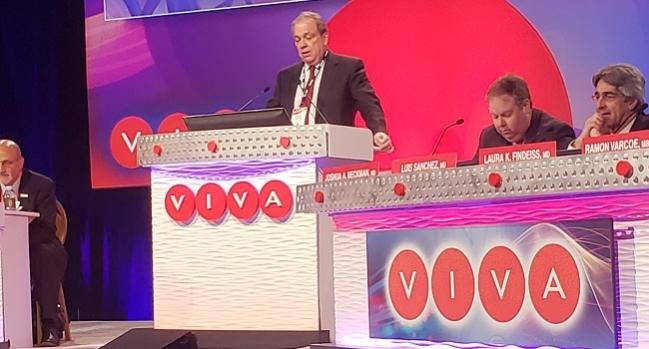VERNACULAR: A Novel Venous Stent Shows Promise for Treatment of Iliofemoral Occlusive Disease
Patency was high even among those with postthrombotic syndrome, and improvements were seen in QoL and venous clinical severity at 1 year.

LAS VEGAS, NV—A self-expanding nitinol stent is effective for the treatment of venous obstructions in the iliac and femoral veins, according to 12-month data from the nonrandomized, multicenter VERNACULAR trial.
Presenting the data here at VIVA 2018, Michael Dake, MD (University of Arizona Health Sciences, Tucson), said treatment with the Venovo venous stent (BD) not only showed a high rate of patency at 1 year, but also was associated with significant improvements in quality of life (QoL) and common clinical features of venous disease.
Dake described the stent, which is investigational in the United States, as having been designed specifically with the demands of veins as opposed to arteries in mind. For example, the ends are flared to enhance vein-wall apposition, "a design feature we don't commonly see," he noted. It also contains six radiopaque tantalum markers (three on each end) and is available in diameters of 10 to 20 mm and lengths from 40 mm to 160 mm.
In a press conference prior to the presentation, Dake was hesitant to affirm the need for a dedicated venous stent.
“I hate to just say ‘Yes, there has to be a venous stent,’ but in reality I think that these new-generation stents used in the iliac veins are actually custom-tailored to what is our best understanding of what would do well in that particular type of vessel,” he said.
In an interview with TCTMD, Sahil A. Parikh, MD (NewYork-Presbyterian/Columbia University Irving Medical Center, New York, NY), noted that venous obstruction is “an underrecognized and quite common problem in this patient population.” A Food and Drug Administration (FDA)-approved dedicated venous stent, he added, “would be a move forward for the field.”
Primary Patency Better Than Performance Goal
For the VERNACULAR trial, 170 patients with iliac and femoral vein occlusive disease, including acute or chronic deep vein thrombosis and/or May-Thurner syndrome, were enrolled at 22 sites in the US, Europe, and Australia. All had symptomatic venous outflow obstructions in the iliac and femoral veins of 50% or greater. Postthrombotic syndrome (PTS) was present in 93 patients, while the remaining 77 patients had nonthrombotic iliac vein lesions. Mean lesion length was longer in those with PTS at 80.5 ± 42.8 mm compared with 55.2 ± 32.0 mm in those without PTS, and mean percent diameter stenosis was 81.0 ± 18.4 mm and 69.3 ± 12.6 mm, respectively. The number of stents used per patient was slightly higher in the PTS group than in the non-PTS group (1.4 vs 1.1), which Dake noted was owing to the longer lesion lengths.
At 12 months, the primary patency was greater than a literature-derived performance goal of 74%. In the intent-to-treat population, primary patency was 81.3% in patients with PTS and 96.9% in those without PTS. For the group as a whole, patency was 88.3%. Freedom from TLR and TVR at 12 months was 87.6% in the PTS group and 98.6% in the non-PTS group. The rate of core-lab-adjudicated stent fracture was zero.
Venous clinical severity score (VCSS) showed improvement from baseline to 30 days that was maintained at 12 months in all patient groups (P < 0.0001). Similarly, quality of life (QoL) as assessed with the CIVIQ-20 score that measures such things as daily activities, pain, and difficulty sleeping, was statistically improved from baseline in all groups and was maintained out to 12 months (P < 0.0001).
Following Dake’s presentation, moderator Kenneth Rosenfield, MD (Massachusetts General Hospital, Boston, MA), asked about the roughly 20% of patients in the PTS group who did not have primary patency at 12 months. Dake replied that they were a combination of completed occluded and severely stenotic.
Panelist Mehdi Shishehbor, MD (University Hospitals of Cleveland, OH), wanted to know whether there had been any issues during the trial with stent migration. According to Dake, the stent “allows for very accurate delivery” and “it really doesn’t move at all.”
Asked by TCTMD about his confidence that the stent will gain FDA clearance, Dake noted that “all of the data is in to the FDA.” He also said the stent manufacturer “feels pretty confident about the results,” adding that they are in line with those from previous single-center studies of the device. The inclusion of core-lab adjudication to VERNACULAR, Dake observed, “gives us some confidence that this is performing in a way that we think will eventually get the approval.”
The VERNACULAR cohort is being followed through 3 years.
L.A. McKeown is a Senior Medical Journalist for TCTMD, the Section Editor of CV Team Forum, and Senior Medical…
Read Full BioSources
Dake M. 12-month results from the VENOVO venous stent trial. Presented at: VIVA 2018. November 7, 2018. Las Vegas, NV.
Disclosures
- Dake reports honoraria from Bard Peripheral Vascular, Cook Medical and consulting fees from Cook Medical, Gore & Associates, and Novate.


Oscar Berg